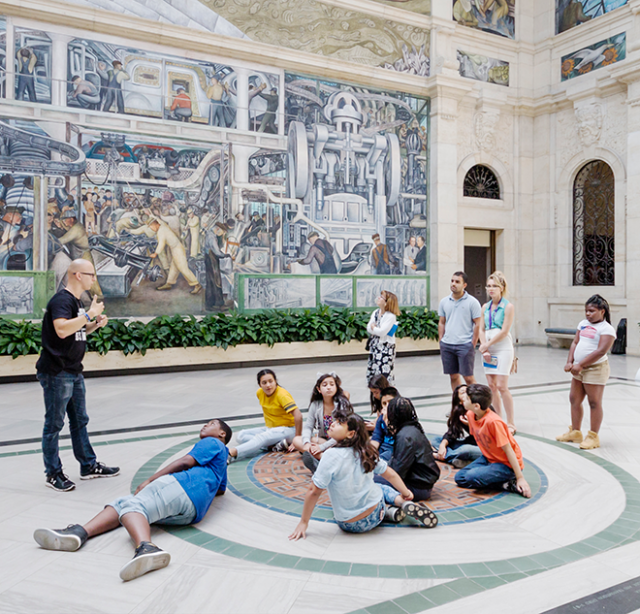From the Director, December 2019
Updated Jul 20, 2022
Growth and Community
I clearly remember when I started to work at the DIA in February of 2008. Detroit welcomed me with a very nice snowstorm and the museum was energized thanks to the recent opening (November 2007) of architect Michael Graves’ building renovation and the reinstallation of the entire collection.
Unfortunately, the museum’s excitement did not last long. A year after I was hired, the DIA had to go through a very tough RIF (reduction in force), because our endowment for operations was too small to support our work and the museum could not raise enough funds to keep the doors open and provide the necessary services to the community. As a consequence, we not only shrank our operating budget by nearly $10 million, but also reduced the number of days we were open to the public. This was a monumental and heartbreaking effort, not only because we had to let go many of our colleagues, but also because our operations were limited to only essential services.
With basically no funding for exhibitions, we were able to organize a show about Fakes and Forgeries using works from our own collection. This was an exercise in art-collecting transparency, where we presented some of the mistakes (“sophisticated” fakes and forgeries) the DIA had acquired in the past and explained how those mistakes had been made. Our visitors loved the show and also appreciated that the DIA presented itself humbly, recognizing and sharing our past errors as a way to learn and grow as a museum.
During the past decade, the DIA has made great strides in transforming its culture to be more outwardly focused rather than being the figurative “inaccessible ivory tower on top of a hill.” Today we are a museum that goes beyond the walls of our building to serve the community and to function as a resource for its residents. We have become a tool for the community and we are very proud of it. Our exhibitions and education programs are changing people’s lives, and often when I am in a public space, in a restaurant, or at a community gathering, someone I do not know makes the point to stop me and thank me for the work the DIA team is doing.
immediately return those thanks and tell them that the DIA is a better place today because of them. In 2012, when the residents of Macomb, Wayne, and Oakland counties voted to provide a millage (a tax based on property) to support the DIA’s operations we did not
Iknow two things: first, that the museum would become an independent organization, holding the art and other assets in perpetual charitable trust for the residents of the City, counties and state. Since 2015, the DIA owns its collection, building and grounds and, of course, its destiny! Second, we could not have known that the millage and the art service agreements (free general admission, free school trips, free senior program, free community partnership programs) that we hold with the residents of Macomb, Oakland, and Wayne counties would transform the organization and dramatically change its internal culture. Thanks to the support of tri-county residents, the DIA serves as a leader in education, providing curriculum-based programs to over 75,000 students each year, plays a crucial role in the comeback of Southeast Michigan, and creates experiences that cannot be found on TV, the internet or in books. 
Next year will be a big one with an extraordinary show on Detroit car design and a Van Gogh exhibition, both opening in June. We are looking forward to continuing our partnerships for years to come with our supporting counties so we can be what all of you have allowed us to become: one the greatest museums in the world. With my heart in my hand and on behalf of the entire organization and our board of directors, I say thank you to all the residents of Macomb, Oakland, and Wayne counties for your trust and for making the DIA a better place for all --- a role model for many museums around the country.

DIA Director, Salvador Salort-Pons in Rivera Court
Growth and Community
I clearly remember when I started to work at the DIA in February of 2008. Detroit welcomed me with a very nice snowstorm and the museum was energized thanks to the recent opening (November 2007) of architect Michael Graves’ building renovation and the reinstallation of the entire collection.
Unfortunately, the museum’s excitement did not last long. A year after I was hired, the DIA had to go through a very tough RIF (reduction in force), because our endowment for operations was too small to support our work and the museum could not raise enough funds to keep the doors open and provide the necessary services to the community. As a consequence, we not only shrank our operating budget by nearly $10 million, but also reduced the number of days we were open to the public. This was a monumental and heartbreaking effort, not only because we had to let go many of our colleagues, but also because our operations were limited to only essential services.
With basically no funding for exhibitions, we were able to organize a show about Fakes and Forgeries using works from our own collection. This was an exercise in art-collecting transparency, where we presented some of the mistakes (“sophisticated” fakes and forgeries) the DIA had acquired in the past and explained how those mistakes had been made. Our visitors loved the show and also appreciated that the DIA presented itself humbly, recognizing and sharing our past errors as a way to learn and grow as a museum.
During the past decade, the DIA has made great strides in transforming its culture to be more outwardly focused rather than being the figurative “inaccessible ivory tower on top of a hill.” Today we are a museum that goes beyond the walls of our building to serve the community and to function as a resource for its residents. We have become a tool for the community and we are very proud of it. Our exhibitions and education programs are changing people’s lives, and often when I am in a public space, in a restaurant, or at a community gathering, someone I do not know makes the point to stop me and thank me for the work the DIA team is doing.
immediately return those thanks and tell them that the DIA is a better place today because of them. In 2012, when the residents of Macomb, Wayne, and Oakland counties voted to provide a millage (a tax based on property) to support the DIA’s operations we did not
Iknow two things: first, that the museum would become an independent organization, holding the art and other assets in perpetual charitable trust for the residents of the City, counties and state. Since 2015, the DIA owns its collection, building and grounds and, of course, its destiny! Second, we could not have known that the millage and the art service agreements (free general admission, free school trips, free senior program, free community partnership programs) that we hold with the residents of Macomb, Oakland, and Wayne counties would transform the organization and dramatically change its internal culture. Thanks to the support of tri-county residents, the DIA serves as a leader in education, providing curriculum-based programs to over 75,000 students each year, plays a crucial role in the comeback of Southeast Michigan, and creates experiences that cannot be found on TV, the internet or in books. 
Next year will be a big one with an extraordinary show on Detroit car design and a Van Gogh exhibition, both opening in June. We are looking forward to continuing our partnerships for years to come with our supporting counties so we can be what all of you have allowed us to become: one the greatest museums in the world. With my heart in my hand and on behalf of the entire organization and our board of directors, I say thank you to all the residents of Macomb, Oakland, and Wayne counties for your trust and for making the DIA a better place for all --- a role model for many museums around the country.

